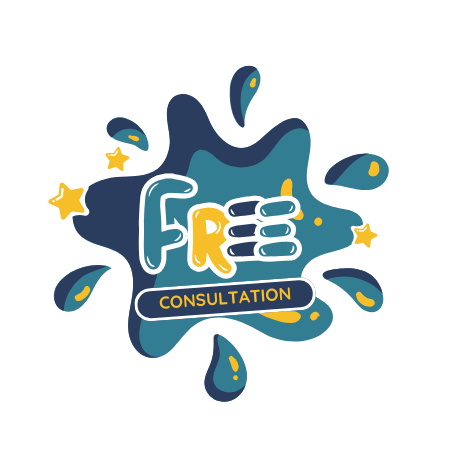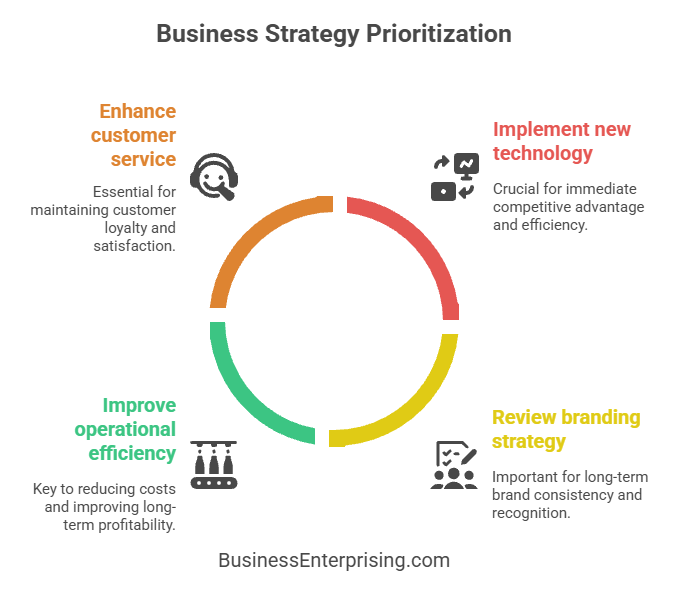 Running a business requires more than offering a good product or service. Competitive pressure forces you to stay sharp and adapt quickly. Therefore, you need a clear strategy that supports both short-term actions and long-term goals. Without structure, it becomes harder to grow or respond to change.
Running a business requires more than offering a good product or service. Competitive pressure forces you to stay sharp and adapt quickly. Therefore, you need a clear strategy that supports both short-term actions and long-term goals. Without structure, it becomes harder to grow or respond to change.
Every part of your business should work together. Your branding, operations, and customer experience all influence results. Additionally, your ability to adjust depends on how well you understand your strengths and weaknesses. When you stay focused, you make better use of your time and resources.
You don’t need to change everything at once. Instead, focus on a few areas that directly impact performance. Therefore, review what is working and where you are falling short. Make small updates and track their impact. Over time, this helps you create a stronger, more stable foundation.
Additionally, involve your team in the process. They see problems you may miss and often have useful ideas. Clear communication helps align your team and keeps projects moving. When everyone understands the priorities, they can make better day-to-day decisions.
Staying competitive requires steady attention, not dramatic shifts. When you take time to plan and improve, your business becomes more resilient. That makes it easier to face challenges and seize new opportunities. You build a system that supports growth without constant stress or confusion.
Understanding the Competitive Landscape
Understanding the competitive landscape helps you make better business decisions. It allows you to spot threats and adapt quickly. Therefore, taking time to review your industry’s players can help you stay focused on growth. You need to know what others are doing before you adjust your strategy.
Start by identifying businesses that offer similar products or services. These are your direct competitors. However, you should also watch companies outside your niche that attract the same customers. Additionally, examine how these businesses price, market, and deliver. That gives you a clear picture of how your brand fits in.
Competitive pressure affects everything from sales to customer loyalty. If your competitors offer more value or better service, customers may switch. Therefore, you need to offer something they can’t easily replace. This could be better support, more consistent results, or stronger relationships. Additionally, tracking what your competitors do helps you avoid falling behind.
Regular reviews keep your strategy current. Look at their new launches, online reviews, and marketing channels. Pay attention to changes in customer behavior. That way, you respond early instead of reacting late. It also helps you find gaps in the market others may miss.
Understanding your competitive environment is not about copying others. It’s about finding ways to stand out. Therefore, use what you learn to refine your offer and strengthen your brand. By knowing where you stand, you can move forward with more clarity. Your strategy becomes sharper, and your business becomes harder to compete with.
Fostering Innovation and Differentiation
Fostering innovation starts with looking at how your business creates value. You need to think beyond what’s expected or standard. Therefore, challenge old habits and question what can be improved. Innovation often begins when you notice what others overlook.
Your team can support this process when you create space for new ideas. Encourage regular feedback from customers and staff. Additionally, test small changes and measure the outcome. That way, you reduce risk while building momentum. Even small innovations can improve the customer experience or reduce costs.
Differentiation is what makes you stand out. It helps people remember your business and return to it. Therefore, focus on what you do better or differently than others. This could be your service model, product design, or pricing strategy. Additionally, clarity in your message helps customers understand your unique value.
Competitive pressure makes innovation even more important. If others copy your ideas, you need to stay ahead. Therefore, treat innovation as an ongoing process. Look for improvements across all parts of your business, not only in products. Additionally, monitor trends and customer preferences to spot new opportunities.
Innovation and differentiation work best when linked to your brand goals. Keep your ideas focused on what your customers care about. That keeps your improvements aligned with business growth. When you stay proactive, you avoid relying on outdated advantages. Over time, you build a business that adapts faster and competes on more than price.
Leveraging Technology and Data Analytics
Technology helps you run your business more efficiently and make better decisions. When used correctly, it can save time and reduce costs. Therefore, you should look for tools that improve your daily operations. Automation, scheduling, and cloud software are all common examples.
Data analytics goes one step further. It helps you understand what is happening in your business and why. Additionally, it reveals trends in sales, customer behavior, and inventory. This allows you to respond faster and plan ahead. Without data, you risk making decisions based on assumptions instead of facts.
You don’t need complex systems to get started. Many tools collect data in the background. Therefore, begin by reviewing reports you already have. Look for patterns in what sells, when customers buy, or how long tasks take. Over time, you can add more tools based on your needs.
Competitive pressure makes this even more important. When other businesses adapt faster, you may fall behind. Therefore, using real-time data gives you an advantage. It allows you to improve performance without guessing. Additionally, it helps you test ideas and track the results.
The goal is not to collect more data. The goal is to use it to make better decisions. You should focus on key areas that impact profit and growth. That way, your tools support clear business goals instead of adding complexity. Over time, the right systems help you work smarter and stay ahead. With better insight, your business can grow with less waste and more focus.
Building a Strong Brand
A strong brand helps people remember your business and builds long-term trust. Your brand is more than your logo or name. It includes how your business sounds, looks, and responds. Therefore, every message you send should match your values and tone.
Consistency matters. People notice when your website, emails, and social media all feel the same. Additionally, this builds confidence over time. Customers begin to expect a certain experience from you. When you deliver that experience, they are more likely to return and refer others.
Competitive pressure makes branding even more important. If your competitors offer similar products, your brand can make the difference. Therefore, focus on what makes your approach unique. It might be your service style, your packaging, or your tone. Additionally, customer reviews and referrals often reflect brand strength more than pricing.
Your team plays a role too. Train staff to reflect your values in their daily interactions. This consistency helps shape how people view your business. Therefore, clear internal communication matters as much as public messaging. You want your team aligned with what your brand stands for.
Additionally, take time to listen to how customers talk about your business. Their feedback shows what’s working and what needs adjustment. You can use this to fine-tune your message. Over time, a strong brand becomes a reliable asset. It supports pricing power, builds loyalty, and helps you grow without needing constant promotions.
Enhancing Customer Relationships
Strong customer relationships build trust and drive repeat business. People are more likely to return when they feel heard and supported. Therefore, you should make service a core part of your daily operations. Even small interactions can create long-term loyalty.
Listen closely to what your customers need. Their feedback offers insight into how your products or services perform. Additionally, you can learn what keeps them coming back. Use this information to improve your offers and strengthen communication. When you respond quickly and clearly, you show that their experience matters.
Competitive pressure makes it harder to rely on price or features alone. Therefore, service becomes your advantage. A quick reply, a helpful tone, or a follow-up message can set you apart. Additionally, customers are more likely to refer others when they feel valued. That kind of connection drives long-term growth.
Train your team to treat every customer as a priority. That includes being consistent, clear, and respectful. Over time, these habits build your reputation. Therefore, keep your team informed and focused on service. Everyone should understand how their actions impact the customer experience.
Additionally, stay in touch with customers after the sale. Use email, surveys, or check-ins to keep the relationship active. That ongoing contact shows commitment and keeps your business top of mind. You don’t need to overwhelm people. A simple message now and then keeps the door open. When customers trust you, they stay longer and spend more. That helps you compete in any market.
Focusing on Operational Efficiency
Operational efficiency helps you do more with less. It allows your business to grow without wasting time, money, or resources. Therefore, finding ways to improve your daily workflow can make a big impact. Even small adjustments can lead to long-term gains.
Start by reviewing how tasks are done each day. Look for steps that take too long or cause delays. Additionally, ask your team for feedback. They often know where the slowdowns happen. Fixing those gaps creates smoother processes and fewer errors. Over time, this builds a stronger foundation for growth.
Competitive pressure makes efficiency more important than ever. If other companies deliver faster or cheaper, you need to match their pace. Therefore, improving operations helps you compete without lowering quality. It also frees up resources for new projects. Additionally, customers notice when things run smoothly. That can set you apart.
Technology can support this process. Use tools that simplify scheduling, inventory, or communication. However, avoid systems that add complexity without solving problems. The goal is to make work easier, not harder. Therefore, choose software that fits your size and goals.
Additionally, review your process regularly. What worked last year may not work now. Business conditions change, and so should your approach. Involve your team in those updates. When they understand the value of efficiency, they are more likely to support the effort. Over time, operational improvements reduce costs and increase profit. You build a business that runs cleaner, reacts faster, and wastes less. That puts you in a stronger position no matter the market conditions.
Investing in Employee Development
Your employees shape the customer experience, product quality, and company culture. Investing in their development improves performance across every area of your business. Therefore, training and growth should be part of your regular operations. A skilled team can handle more and make better decisions.
Start by identifying key skills your team needs. Focus on areas that support your goals and improve daily work. Additionally, involve employees in the planning process. Ask them what support or training would help them grow. When people feel supported, they tend to work harder and stay longer.
Competitive pressure affects hiring and retention. When other businesses offer better growth paths, you risk losing top talent. Therefore, training programs help you stay competitive. They show your team that you care about their future. Additionally, people who gain new skills often find more purpose in their roles.
Training does not always require large budgets. You can provide learning through mentoring, cross-training, or short sessions. The key is to offer something consistent. Therefore, build development into your schedule, not as a one-time event. Over time, your team becomes stronger and more adaptable.
Additionally, development creates a bench of future leaders. You reduce the need to hire from outside. That helps you maintain your culture as your business grows. When people move into new roles, they bring experience and loyalty with them. Your business becomes more stable and better prepared for change. By supporting employee growth, you create a stronger, more committed team that’s ready to meet new challenges.
Conclusion
Every part of your business contributes to long-term performance. You need clear goals, steady action, and a focus on what works. Therefore, it makes sense to review your strategy often and adjust based on what you learn. Small improvements can lead to stronger results over time.
Additionally, your ability to adapt matters more than ever. Customer expectations shift quickly, and technology continues to change how you operate. Competitive pressure forces you to stay alert and flexible. Therefore, build habits that help you respond without delay. You don’t need to overhaul everything at once.
Focus on what helps you serve customers better and run more efficiently. Track results and update your plans based on real data. Additionally, involve your team so they understand what matters most. That creates buy-in and reduces confusion. When everyone pulls in the same direction, you move faster with less effort.
Strong systems, solid training, and clear branding all work together. Each one supports the others and reduces wasted time and resources. Therefore, don’t treat strategy like a one-time task. Keep it active and tied to your daily work. Over time, you will notice smoother operations and better customer feedback.
You can stay competitive without constant pressure or guesswork. Review, improve, and communicate clearly. That steady rhythm helps your business stay strong through change. With a clear focus and consistent execution, you give yourself a better chance to grow and adapt without losing momentum.


